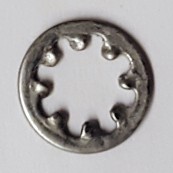 he last time I visited an art gallery, I was captivated by a beautifully sculpted
white object attached to the wall. It was pure white, almost blending into the wall,
and it had small groves in the front and an indentation that curved elegantly
around its perimeter. Unlike the other statues in the gallery, this one seemed
modest and almost functional, more like a beautiful piece of engineering than
an art object.
he last time I visited an art gallery, I was captivated by a beautifully sculpted
white object attached to the wall. It was pure white, almost blending into the wall,
and it had small groves in the front and an indentation that curved elegantly
around its perimeter. Unlike the other statues in the gallery, this one seemed
modest and almost functional, more like a beautiful piece of engineering than
an art object.

McMaster-Carr's famous “Zinc-Plated Internal Tooth Lock Washer for #10 screw”
The other pieces of stuff in the room left no impression on me; if they'd been in my attic, I would have thrown them away. But I would have paid a lot for that thermostat after the one in my house crapped out.
Much of modern art is like this: the idea is not so much to shock us—after two world wars and uncounted genocides that is not so easy—but to attempt to make us see ordinary things, like toilets and unmade beds, in a new light by promoting them as art objects. This was clever for, oh, about five minutes in 1921 before it became a cliché. Unfortunately, the idea that slapping it into a gallery makes it art degrades the term in much the same way that claiming everything bad that happens to an ethnic group is a form of genocide.
Maybe that's what drives the artists who create those hyperrealistic paintings that look exactly like photographs. These turn up in the Daily Mail from time to time, when they run out of those find-the-panda works—a form of purely functional art that is, by all accounts, hugely popular.
Abstract expressionism reached its apex in Jackson Pollock, whose works created an impression of sublime sophistication, which is all the more remarkable for the fact that they were little more than drabs of house paint dripped and splashed on giant canvases. Even those Rothko paintings, which consisted solely of one or maybe two big colored rectangles, sometimes achieved that elusive quality called visual sophistication. Other times they just looked depressing. (That couldn't have been the intent. Art galleries are depressing enough already, mausoleums of attempts to communicate pinned to the wall like a butterfly collection; I'd much rather visit an oil refinery.)
The same thing happened with music. Wagner and others stretched tonality beyond the limits of endurance in the late 19th century, and representational tonal music came to be regarded as dull and predictable. Debussy, Schönberg, and their followers turned to dissonance in an attempt to revitalize it.

“Plastic Squirt Bottle” by Unknown. Note the artist's clever use of subtle colors and the slight angle of the plastic bottle, symbolizing how the oceans have gone out of balance thanks to the artificial world of plastic. (Note: this item is still available!)
Eventually we got music that consisted of slowed-down recordings of train boxcars bumping into each other. The Guardian called them “works of shattering visceral power,“ but even they would probably admit that they were hard to dance to, and since humans are first and foremost social animals, they were nonfunctional and therefore rejected.
Last week I heard a rock tune called Calculating Infinity, an example of a supposed new kind of music (well, new to me, anyway) called math rock. The title seemed to suggest great mathematical sophistication, but in fact there seems to be very little actual math in there.* It turns out that putting advanced math into music, as Ioannis Xenakis tried to do, is not so easy, and success doesn't translate to popularity. Maybe this is telling us that all those people telling us that music is mathematical were just making it all up, and it's all about symmetry and repetition—set theory and what Xenakis calls Markovian stochastic theory being a mere acquired taste.
Don't get me wrong. There is great music out there, notably by Ligeti, Scriabin, and Arvo Pärt. Pärt's compositions bring religious experience, which had been slowly disappearing since Bach, back into Western music. Ravel's Le gibet from Gaspard de la nuit is a haunting depiction of death. And even Schönberg, when played by somebody who understands it, can sometimes be interesting.
But what seems to have happened was that our artists rejected the idea of being useful. If it serves a social purpose, which religion indisputably does, it's not artistic by definition. But it was also a rejection of the idea of being affected emotionally, replacing sentimentality with irony, which distances the viewer from the need to be affected.
Irony is easy to generate. It can be applied to everything, and it gives you a sense of gravity while protecting you from the actual ideas, and so it leads to sterility.
Well, what with God being dead and all, maybe it was our spirit that died first. But in fact valuing style over substance, which gives that Guardian article its indefinable upchuck-inducing quality, also makes all those exhibits of unmade beds and cans of human excrement in the Tate Gallery so unappealing. Substance always wins in the end, because it has a connection to the real world. The rest gets shit-canned, if it doesn't explode first.
In some ways it might be science envy: scientists turn ordinary things into important objects of study. They're not supposed to care what is actually happening to the world, or to the ants they're studying; the only valid goal is to explain it. Everything becomes an airplane movie: we watch it with the sound off, ignoring the plot and the acting because both are terrible, the alternative is to do nothing, and we're literally tied to the seat.
There's a cost to this. Given that we've rejected all the things that make us care about anything, we shouldn't be surprised that there's not much left worth caring about.
Well, except maybe the HVAC system, which (when it works) makes no sound at all. But John Cage turned even that into a cliché. His finest work, 4:33, consists of 4½ minutes of silence, and a downloadable zipped WAV file of a superb piano interpretation of it is only 3,108 bytes long, indicating a low information content. Make of that what you will.
* I must admit, though, that I couldn't make out all the lyrics, so there could have been a line like “We'll divide by zero” in there that I missed.
dec 30, 2017, 8:02 am. last edited jan 05 2018, 7:10 am
